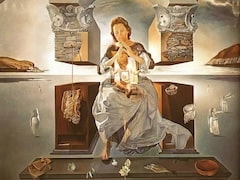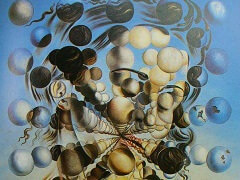Allegory of an American Christmas, 1934 by Salvador Dali

Allegory of an American Christmas was painted in 1934, while Dali and Gala were on the first of what was to become many visits to the US. The country had long intrigued Dali and on this first trip, he was greatly impressed with it, especially with the media, who afforded him the attention that he needed and craved. Dali loved the idea of a "new country" and the opportunities he saw there; these feelings are reflected in the painting.
Dali used the image of an egg-shaped stone often during the Thirties. In the Allegory of an American Christmas, as with the later painting The Metamorphosis of Narcissus, the egg produces the idea of hatching or birth of something new; of a change taking place. Here, the huge stone egg fills the painting, hovering ominously over the flat, blue land. The dark clouds on the horizon heighten the atmosphere of expectancy. A distorted golden plane is breaking free from a hole in the egg. The black hole forms the shape of the northern US, with South America painted in golden colors beneath it.























